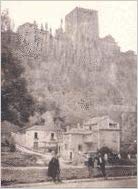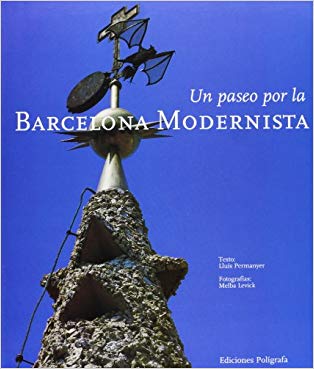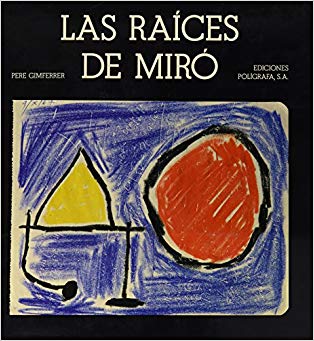Ir al contenidoArtes: aspectos generales










 La arquitectura modernista fue creada no sólo con fe por los innúmeros arquitectos que la proyectaron, sino con el convencimiento absoluto de los propietarios. Una serie de circunstancias sociales favorables, pero sobre todo la aludida coincidencia de pasiones cristalizó en un Eixample que por tales razones es único en el mundo. Las páginas de este libro muestran un rosario de obras deslumbrantes, enfilado en el discurrir de un itinerario que quiere ser un paseo culto y amable, cívico y estimulante, que permita admirar, saborear y quizá descubrir, pero que orilla la tentación de catálogo.
La arquitectura modernista fue creada no sólo con fe por los innúmeros arquitectos que la proyectaron, sino con el convencimiento absoluto de los propietarios. Una serie de circunstancias sociales favorables, pero sobre todo la aludida coincidencia de pasiones cristalizó en un Eixample que por tales razones es único en el mundo. Las páginas de este libro muestran un rosario de obras deslumbrantes, enfilado en el discurrir de un itinerario que quiere ser un paseo culto y amable, cívico y estimulante, que permita admirar, saborear y quizá descubrir, pero que orilla la tentación de catálogo.
 The New Museum, designed by Tokyo-based architects Kazuyo Sejima and Ryue Nishizawa/SANAA (2010 Pritzker Prize), is the first art museum ever constructed from the ground up in downtown Manhattan,as well as an architectural contribution to NewYorks urban landscape. Sejima and Nishizawa, who received the commission in 2002, have described the building as their response to the history and powerful personalities of both the New Museum and its site. The Bowery was very gritty when we first visited it, they have said.We were a bit shocked, but we were also impressed that a contemporary art museum wanted to be there. As visitors approach the Bowery, they encounter the building as a dramatic stack of seven rectangular boxes.This distinctive form derives directly from the architects defining solution to fundamental challenges of the site: A dense and ambitious program, including the need for open, flexible gallery spaces of different heights and atmospheres. The New Museum is clad in a seamless, anodized expanded aluminum mesh chosen by SANAA to emphasize the volumes of the boxes while dressing the whole of the building with a delicate, filmy, softly shimmering skin.With windows just visible behind this porous scrim-like surface, the building appears as a single, coherent, and even heroic form that is nevertheless mutable, dynamic, and animated by the changing light of dayan appropriate visual metaphor for the openness of the New Museum and the ever-changing nature of contemporary art.
The New Museum, designed by Tokyo-based architects Kazuyo Sejima and Ryue Nishizawa/SANAA (2010 Pritzker Prize), is the first art museum ever constructed from the ground up in downtown Manhattan,as well as an architectural contribution to NewYorks urban landscape. Sejima and Nishizawa, who received the commission in 2002, have described the building as their response to the history and powerful personalities of both the New Museum and its site. The Bowery was very gritty when we first visited it, they have said.We were a bit shocked, but we were also impressed that a contemporary art museum wanted to be there. As visitors approach the Bowery, they encounter the building as a dramatic stack of seven rectangular boxes.This distinctive form derives directly from the architects defining solution to fundamental challenges of the site: A dense and ambitious program, including the need for open, flexible gallery spaces of different heights and atmospheres. The New Museum is clad in a seamless, anodized expanded aluminum mesh chosen by SANAA to emphasize the volumes of the boxes while dressing the whole of the building with a delicate, filmy, softly shimmering skin.With windows just visible behind this porous scrim-like surface, the building appears as a single, coherent, and even heroic form that is nevertheless mutable, dynamic, and animated by the changing light of dayan appropriate visual metaphor for the openness of the New Museum and the ever-changing nature of contemporary art.
 The art magazine Interfunktionen, published in Cologne from 1968 to 1975, drew together much of Central European artistic activity of the sixties and seventies. A prestigious review directly linked to the most prominent figures in the Düsseldorf Kunstacademie (Beuys, Immendorf, Polke...) it also boasted the direct involvement of the most spirited and reflexive artists of the times (Acconci, Broodthaers, Nauman, Roth...). This book has been produced in collaboration with Fritz Heubach, the first editor of the review, and depicts the experience of those years by means of original documents (some of them hitherto unpublished), artworks and artists writings.
The art magazine Interfunktionen, published in Cologne from 1968 to 1975, drew together much of Central European artistic activity of the sixties and seventies. A prestigious review directly linked to the most prominent figures in the Düsseldorf Kunstacademie (Beuys, Immendorf, Polke...) it also boasted the direct involvement of the most spirited and reflexive artists of the times (Acconci, Broodthaers, Nauman, Roth...). This book has been produced in collaboration with Fritz Heubach, the first editor of the review, and depicts the experience of those years by means of original documents (some of them hitherto unpublished), artworks and artists writings.







 La arquitectura modernista fue creada no sólo con fe por los innúmeros arquitectos que la proyectaron, sino con el convencimiento absoluto de los propietarios. Una serie de circunstancias sociales favorables, pero sobre todo la aludida coincidencia de pasiones cristalizó en un Eixample que por tales razones es único en el mundo. Las páginas de este libro muestran un rosario de obras deslumbrantes, enfilado en el discurrir de un itinerario que quiere ser un paseo culto y amable, cívico y estimulante, que permita admirar, saborear y quizá descubrir, pero que orilla la tentación de catálogo.
La arquitectura modernista fue creada no sólo con fe por los innúmeros arquitectos que la proyectaron, sino con el convencimiento absoluto de los propietarios. Una serie de circunstancias sociales favorables, pero sobre todo la aludida coincidencia de pasiones cristalizó en un Eixample que por tales razones es único en el mundo. Las páginas de este libro muestran un rosario de obras deslumbrantes, enfilado en el discurrir de un itinerario que quiere ser un paseo culto y amable, cívico y estimulante, que permita admirar, saborear y quizá descubrir, pero que orilla la tentación de catálogo. The New Museum, designed by Tokyo-based architects Kazuyo Sejima and Ryue Nishizawa/SANAA (2010 Pritzker Prize), is the first art museum ever constructed from the ground up in downtown Manhattan,as well as an architectural contribution to NewYorks urban landscape. Sejima and Nishizawa, who received the commission in 2002, have described the building as their response to the history and powerful personalities of both the New Museum and its site. The Bowery was very gritty when we first visited it, they have said.We were a bit shocked, but we were also impressed that a contemporary art museum wanted to be there. As visitors approach the Bowery, they encounter the building as a dramatic stack of seven rectangular boxes.This distinctive form derives directly from the architects defining solution to fundamental challenges of the site: A dense and ambitious program, including the need for open, flexible gallery spaces of different heights and atmospheres. The New Museum is clad in a seamless, anodized expanded aluminum mesh chosen by SANAA to emphasize the volumes of the boxes while dressing the whole of the building with a delicate, filmy, softly shimmering skin.With windows just visible behind this porous scrim-like surface, the building appears as a single, coherent, and even heroic form that is nevertheless mutable, dynamic, and animated by the changing light of dayan appropriate visual metaphor for the openness of the New Museum and the ever-changing nature of contemporary art.
The New Museum, designed by Tokyo-based architects Kazuyo Sejima and Ryue Nishizawa/SANAA (2010 Pritzker Prize), is the first art museum ever constructed from the ground up in downtown Manhattan,as well as an architectural contribution to NewYorks urban landscape. Sejima and Nishizawa, who received the commission in 2002, have described the building as their response to the history and powerful personalities of both the New Museum and its site. The Bowery was very gritty when we first visited it, they have said.We were a bit shocked, but we were also impressed that a contemporary art museum wanted to be there. As visitors approach the Bowery, they encounter the building as a dramatic stack of seven rectangular boxes.This distinctive form derives directly from the architects defining solution to fundamental challenges of the site: A dense and ambitious program, including the need for open, flexible gallery spaces of different heights and atmospheres. The New Museum is clad in a seamless, anodized expanded aluminum mesh chosen by SANAA to emphasize the volumes of the boxes while dressing the whole of the building with a delicate, filmy, softly shimmering skin.With windows just visible behind this porous scrim-like surface, the building appears as a single, coherent, and even heroic form that is nevertheless mutable, dynamic, and animated by the changing light of dayan appropriate visual metaphor for the openness of the New Museum and the ever-changing nature of contemporary art. The art magazine Interfunktionen, published in Cologne from 1968 to 1975, drew together much of Central European artistic activity of the sixties and seventies. A prestigious review directly linked to the most prominent figures in the Düsseldorf Kunstacademie (Beuys, Immendorf, Polke...) it also boasted the direct involvement of the most spirited and reflexive artists of the times (Acconci, Broodthaers, Nauman, Roth...). This book has been produced in collaboration with Fritz Heubach, the first editor of the review, and depicts the experience of those years by means of original documents (some of them hitherto unpublished), artworks and artists writings.
The art magazine Interfunktionen, published in Cologne from 1968 to 1975, drew together much of Central European artistic activity of the sixties and seventies. A prestigious review directly linked to the most prominent figures in the Düsseldorf Kunstacademie (Beuys, Immendorf, Polke...) it also boasted the direct involvement of the most spirited and reflexive artists of the times (Acconci, Broodthaers, Nauman, Roth...). This book has been produced in collaboration with Fritz Heubach, the first editor of the review, and depicts the experience of those years by means of original documents (some of them hitherto unpublished), artworks and artists writings.




 Recull una sèrie de reflexions i debats dels intel·lectuals que participaren a l a IV Trobada Internacional, provinents de 19 països i dels més diversos àmbits.
Recull una sèrie de reflexions i debats dels intel·lectuals que participaren a l a IV Trobada Internacional, provinents de 19 països i dels més diversos àmbits.